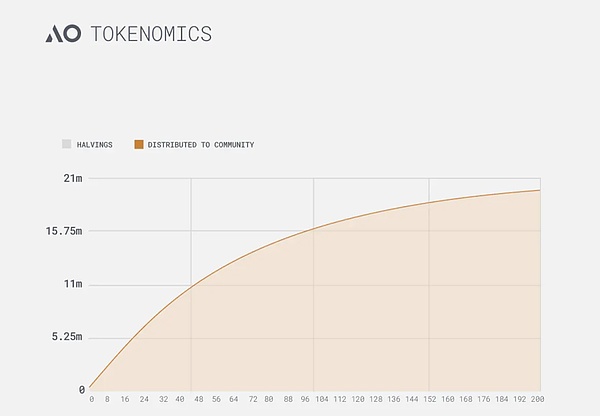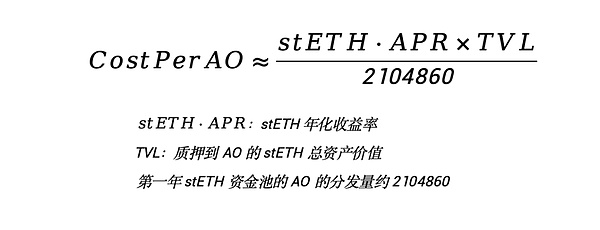Source: PermaDAO
The acquisition of AO depends on the amount of funds and the type of token assets held. What we have to do is to seek the maximum efficiency of AO token acquisition under the limited amount of funds.
Arweave officially released the AO token economics at 23:00 on June 13th, Beijing time. Based on the existing information, we will analyze how to obtain AO tokens from the perspective of maximizing efficiency. This article is only used for cryptocurrency economics analysis and does not make any investment advice!
Interpretation of the AO Token Economics Model
According to the AO token economics, AO is a 100% fair launch token that follows the Bitcoin economic model. Like Bitcoin, the total supply of AO is 21 million tokens, similar to the halving cycle of 4 years. AO is distributed every 5 minutes, and the monthly distribution is 1.425% of the remaining supply. However, unlike Bitcoin, although AO is halved every 4 years, there will not be a sudden "halving event". As we all know, Bitcoin is halved every 210,000 blocks (one block every 10 minutes on average), which is about a four-year dimension, but the halving of AO tokens is a relatively stable process, and token issuance is to reduce the supply on a monthly basis. Although this will not have a big impact on the efficiency of obtaining AO, the early acquisition of AO cannot be ignored, and the earlier the gain, the greater the benefit.

At the same time, the official has been mentioning that AO tokens are 100% fair launch tokens. At present, the official understanding of "100% fair launch" is that AO tokens can only be obtained by holding specific assets (currently $AR, $AOCRED, $stETH), even if the official has not reserved shares for its own team, investment institutions, ecological community projects, etc., compared with many crypto projects on the market, this point highlights the overall situation of the project party, and also declares that the acquisition of AO depends entirely on the amount of funds and the type of token assets held. What we have to do is to seek the maximum efficiency of AO token acquisition under the limited amount of funds.
The acquisition of AO tokens is currently divided into two stages. The first stage ended on June 18, and the second stage started at the same time. The acquisition of the first phase was also known to everyone when the token economics was announced on June 13, but it was reasonable. From February 27, 2024 (AO public test network launch) to June 18, 100% of the AO tokens minted will be issued to $AR token holders, based on the balance held in each wallet address every 5 minutes. As of June 13, 2024, each $AR can obtain approximately 0.016 AO tokens, and a total of more than 1 million AO tokens will be issued in the entire first phase.
Strategy for maximizing the acquisition of AO tokens
The circulation in the first phase only accounts for about 5%, and the second phase is the highlight. The focus of our attention is also how to maximize the acquisition of AO tokens in the second phase. 33.3% of AO tokens will be distributed to AR token holders, 66.6% of AO will be used to stake other assets in AO (currently only stETH), and AOCRED will be exchanged for AO at a ratio of 1000:1 (this part of AO will be provided from the AO tokens generated by AR held by Forward Research).
After the launch of the second phase, each AR can obtain 0.016 AO in the first year, and the number of AO tokens obtained by depositing other qualified cross-chain assets (non-AR assets) into the AO network is determined by the trading volume of the cross-chain assets multiplied by the ratio of their annual staking yield to the total amount of cross-chain assets. Currently stETH is the only qualified cross-chain asset, so 66.6% of AO is used to distribute to other assets pledged in AO. The shares will be given to the stETH fund pool, so you can simply understand that the exact number of AO tokens received by staking stETH depends on the ratio of the value of your staked stETH to the total asset value of the fund pool.
If the assets you pledge account for 0.01% of the total assets in the fund pool, you can get 210 AOs for one year. The current pool is more than 20 million US dollars (you can see it here). If the TVL of the fund pool is 1 billion US dollars after the second phase is opened and remains constant within a year, if you pledge 1,000 US dollars worth of stETH, then you can get 2.1 AOs after one year; if the market value of AR is 2 billion US dollars and remains constant within a year, if your wallet holds 1,000 US dollars of AR, then you can get 0.485 AOs after one year. It seems that staking stETH is more cost-effective. This is indeed the case at present, but the market value of the stETH fund pool and AR cannot remain unchanged within a year. It is still necessary to always calculate based on the ratio of the TVL of other asset fund pools to the market value of AR (calculated in USD standard):
When the fund pool TVL / AR market value ≈ 2 When the fund pool TVL / AR market value > 2, holding AR of the same value will get more AO than staking other assets of the same value; When the fund pool TVL / AR market value < 2, staking other assets of the same value will get more AO than holding AR of the same value; Note that the AO tokens minted after the launch of the second phase will not be unlocked until February 8, 2025, when the circulation rate will be 15%, and the total circulation will be about 3 million. In addition, we can also calculate the risk and cost of obtaining AO, which also greatly affects the subsequent price of AO. AR holders only need to hold it, while stETH is obtained by staking ETH in Lido. The current APR (annualized rate of return) of stETH is 3.3%. Since stETH needs to be pledged in AO, this part of the annualized interest income needs to be given to the AO project party, and this part of the income was originally the vested interest of stETH holders, so the APR of stETH can be regarded as the cost of stETH pledgers. If the TVL of the fund pool reaches 1 billion, the cost of stETH pledgers to obtain AO is US$15.7, but this is the calculation result under the control of variables. The specific calculation formula is (Only considering the current situation where stETH is the only cross-chain asset):

For short-term investors, both staking stETH and holding AR need to bear the risk of falling currency prices. Of course, many CEXs provide 0-leverage loan services, and the loan interest rate is usually not higher than 1%. However, considering the long payback period for obtaining AO incentives, please make your own decisions after weighing the pros and cons. At the same time, the current cost of exchanging AOCRED for AO is about 50-60 US dollars per AO (please make sure to convert AOCRED into AO before June 27, 2024, otherwise it will be invalid). It also needs to wait until February 8, 2025 to unlock, so the price of 1000*AOCRED can be regarded as the AO futures price. However, after the release of the AO test network, the market value of AR will increase by far more than 1 billion, and the total circulation will be only more than 3 million by then, so the AO coin price also has a lot of room for imagination.
For long-term investors, using time to eliminate the risk of market fluctuations can not only obtain the dividend of the principal increase, but also continue to eat AO interest (including AO growth dividends).
Summary
The above is an analysis of AO tokens. To sum up, we should pay attention to the changes in the TVL and AR market value of the fund pool, and adjust the strategy based on the acquisition cost of the token to maximize the efficiency of funds. In addition to considering the cost, the potential risks of currency price fluctuations cannot be ignored. Strategies such as 0-leverage borrowing can avoid some risks, and the cost of exchanging AOCRED for AO and the unlocking time are also important factors to consider when making decisions. Of course, long-term holding of coins only requires waiting for the flowers to bloom.
 JinseFinance
JinseFinance
 JinseFinance
JinseFinance JinseFinance
JinseFinance JinseFinance
JinseFinance JinseFinance
JinseFinance JinseFinance
JinseFinance JinseFinance
JinseFinance JinseFinance
JinseFinance JinseFinance
JinseFinance JinseFinance
JinseFinance Clement
Clement